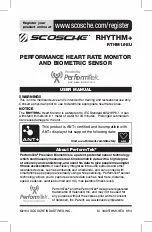
5
PLANNING YOUR EXERCISE
Planning your exercise the right way
If you want to lose weight or prepare for a sports competition,
set the limits for the exercise and exercise using this program.
For the optimal exercise program, define the high and low limits
of your heart rate; which are percentage values of your known
or estimated maximum heart rate (
M
aximum
H
eart
R
ate =
MHR
).
If you have made a test to find your maximum heart rate or if
you are a constantly exercising athlete, you probably know
your "MHR” value.
If you do not know your MHR value, you can estimate your
maximum heart rate using the following equation:
This is how you can calculate your maximum heart rate:
Equation:
MHR = (200 – your age) + K*
*) K = 20 for males
K = 30 for women
For a man aged 36 the following result is obtained:
200 – 36 + 20 = 184 maximum heart rate (
MHR
)
50% of this value = 92
65% of this value = 120
Individuals of the same age may have different maximum
heart rates. The tolerance is about 10-12 bpm (beats per
minute). Persons with cardiopulmonary disease, persons
suffering from obesity and persons who have not exercised for
an extended period of time should know their heart rate
exactly. The safest pulse in a male of good physical constitution
is about 90% of the maximum value (MHR).
Elderly obese persons who are not in good physical condition
must not exercise at heart rate beyond the safe range.




































